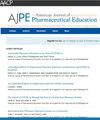标准化病人提供或评估自杀预防培训卫生专业人员:范围审查。
IF 3.5
4区 教育学
Q1 EDUCATION, SCIENTIFIC DISCIPLINES
引用次数: 0
摘要
目的:现有的关于如何使用标准化患者(SPs)向卫生专业人员教授自杀预防技能的综述通常仅限于精神科护理。需要进行更广泛和更深入的评价。研究的目的是探索SPs如何被用于提供或评估卫生专业人员,特别是药剂师的自杀预防培训项目。结果:在整个范围审查过程中遵循PRISMA指南。对标题和摘要进行筛选,并由两名独立编码员对符合条件的文章进行审查,他们提取了九个关键类别的信息,包括学员类型、SP情景、SP类型以及SP方法的优势和局限性。共纳入65项研究。SP方法广泛应用于卫生保健学科,包括药剂师和学生药剂师(n=12)。文章中报告的SP方法的优势是提高知识(n=12),建立学员信心(n=11),发展和实践临床和沟通技巧(n=9)等。总结:SPs被认为是培训卫生专业人员预防自杀技能的有效方法。量身定制的SP方案——由有自杀意念或自杀企图的生活经验的人提供信息——反映了常见的药剂师互动,可以更好地为药剂师在患者出现自杀警告信号时进行干预做好准备。需要进一步的研究来评估非人类虚拟sp在药学教育中的成本效益。本文章由计算机程序翻译,如有差异,请以英文原文为准。
Standardized Patients to Deliver or Evaluate Suicide Prevention Trainings for Health Professionals: A Scoping Review
Objective
Existing reviews on how standardized patients (SPs) have been used to teach suicide prevention skills to health professionals have often been limited to psychiatric nursing. A broader and more in-depth evaluation is needed. The research objective was to explore how SPs have been used to deliver or evaluate suicide prevention training programs for health professionals, particularly pharmacists.
Findings
The Preferred Reporting Items for Systematic Reviews and Meta-Analyses (PRISMA) guidelines were followed throughout this scoping review. Titles and abstracts were screened, and eligible articles were reviewed by 2 independent coders, who extracted information on 9 key categories, including trainee type, SP scenario, type of SP, and strengths and limitations of the SP methodology. A total of 65 studies were included. The SP methodology was used widely across health care disciplines, including pharmacists and student pharmacists (n = 12). Strengths to the SP methodology reported in the articles were improving knowledge (n = 12), building trainee confidence (n = 11), and developing and practicing clinical and communication skills (n = 9), among others.
Summary
SPs were considered an effective way to train health professionals in suicide prevention skills. Tailored SP scenarios, informed by people with lived experience of suicidal ideation or suicide attempts, which reflect common pharmacist interactions, can better prepare pharmacists for intervening when patients exhibit suicidal warning signs. Further research is needed to assess the cost-benefit of nonhuman virtual SPs in pharmacy education.
求助全文
通过发布文献求助,成功后即可免费获取论文全文。
去求助
来源期刊
CiteScore
4.30
自引率
15.20%
发文量
114
期刊介绍:
The Journal accepts unsolicited manuscripts that have not been published and are not under consideration for publication elsewhere. The Journal only considers material related to pharmaceutical education for publication. Authors must prepare manuscripts to conform to the Journal style (Author Instructions). All manuscripts are subject to peer review and approval by the editor prior to acceptance for publication. Reviewers are assigned by the editor with the advice of the editorial board as needed. Manuscripts are submitted and processed online (Submit a Manuscript) using Editorial Manager, an online manuscript tracking system that facilitates communication between the editorial office, editor, associate editors, reviewers, and authors.
After a manuscript is accepted, it is scheduled for publication in an upcoming issue of the Journal. All manuscripts are formatted and copyedited, and returned to the author for review and approval of the changes. Approximately 2 weeks prior to publication, the author receives an electronic proof of the article for final review and approval. Authors are not assessed page charges for publication.

 求助内容:
求助内容: 应助结果提醒方式:
应助结果提醒方式:


